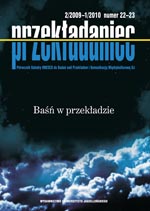Gwiezdny pył czy piasek w oczach?
Star Dust or Sand in the Eyes?
Author(s): Agnieszka RomanowskaSubject(s): Language and Literature Studies
Published by: Wydawnictwo Uniwersytetu Jagiellońskiego
Keywords: literary translation; critical commentary; translation theory; comparative literary studies
Summary/Abstract: In 1834 John Staples Harriot, an English offi cer and amateur linguist, published simultaneously in Paris and London a play entitled Napoléon. Drame politique et historique en cinq actes. A l’imitation de MACBETH, de Shakespear. Ideologically pro-French, the play (written in French) was rooted in the aesthetics of the Shakespearian drama and was composed at the time which naturally inspired its numerous artistic as well as historical and political tensions. Therefore, Harriot tried to justify them and secure for his work as big audiences as he could on both sides of the English Channel by means of the extensive paratextual material. Apart from the appendix which lists various historical sources, he wrote an elaborate preface addressed to his French audience, where he defended the Shakespearian drama conventions, and an afterword with his English version of the scenes borrowed directly from Macbeth, which was supposed to persuade his English audience that the French play was faithful to the original tragedy. Napoléon has never been staged, and is largely forgotten, but recently its textual manipulations have become the focus of detailed historical and literary analysis, which proves that studies of the paratext are important to translatological reflection. Such studies of varied and extensive material (Polish, French, Czech, Italian, Spanish, Latin-American; fiction and non-fiction, children’s and specialized literature) were conducted by a group of Polish scholars in Wrocław and published in 2009 in a volume significantly entitled The Translator’s Glossary (Przypisy tłumacza), edited by Elżbieta Skibińska. Through their detailed (therefore at times overwhelming) presentation, they defy the stereotypical notion of the gloss, especially the footnote, as “dust” (Genette), “parasite” or – less pejoratively – “censor” and “proofreader.” Instead of describing the footnote as “pedantic” or “helpless”, they emphasize its role in conveying and overcoming linguistic and cultural untranslatability. Paratext is a primary way of marking and revealing the translators’ in-betweenness as their inherent positioning.
Journal: Przekładaniec.
- Issue Year: 2009
- Issue No: 22-23
- Page Range: 346-352
- Page Count: 7
- Language: Polish

